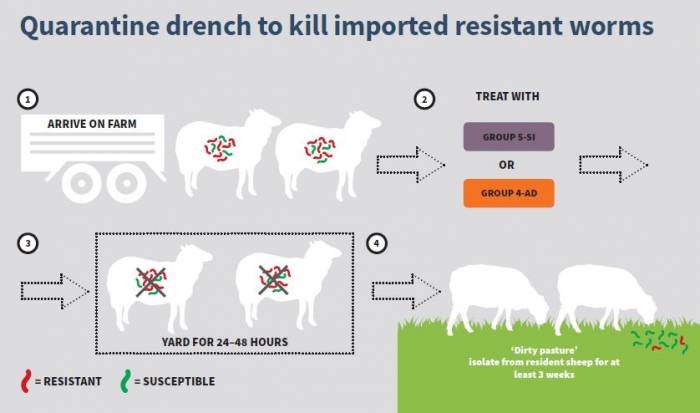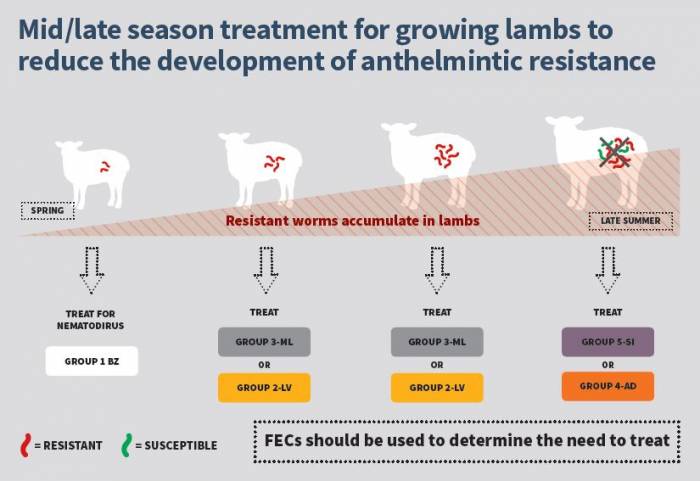The recent publication of the first case of resistance to monepantel (trade name Zolvix) in the UK is a timely and important reminder to sheep farmers and their advisors, says the Sustainable Control of Parasites in Sheep (SCOPS) group.
Speaking on behalf of SCOPS, sheep consultant Lesley Stubbings says: “SCOPS welcomes this report because it not only highlights the need for sheep farmer to follow best practice advice, but also reveals the dangers of not integrating the newer wormer groups into on-farm control programmes before the other groups fail.
“It is SCOPS’ understanding that the farm concerned had a history of triple resistance to the 1-BZ (white), 2-LV (yellow) and 3-ML (clear) groups of anthelmintics, which meant they were relying almost exclusively on the newer monepantel wormer, the 4-AD (orange) group, for worm control. Coupled with animals being moved to low challenge pasture following treatment, which is highly selective for resistance, there was the risk of a ‘perfect storm’ in terms of the development of resistance. Other sheep farmers can avoid this situation by following SCOPS guidelines on the use of the 4-AD and 5-SI (purple) wormers.”
SCOPS has been advising that the group 4-AD and 5-SI wormers should be carefully incorporated into control programmes on sheep farms for the last eight years (when Zolvix was launched) as a quarantine drench and a mid/late season treatment for lambs. That advice was given in order to avoid this sort of situation where the other three groups are no longer effective and the group 4AD is relied upon.
SCOPS advice on orange and purple wormers:-
- The two newest wormer groups (4-AD and 5-SI) should be incorporated into worm control programmes on all sheep farms, not left ‘on the shelf’ until the others are no longer effective. Their real value is in prolonging the life of 1-BZ, 2-LV and 3-ML groups.
- There are only two occasions when a group 4-AD or 5-SI should be used and SCOPS suggests farmers alternate between the two groups. The two occasions are quarantine, and mid/late season as a ‘one off’ annual drench for lambs.
- Groups 4-AD and 5-SI should only be used at other times under veterinary direction and then only if the full anthelmintic resistance status of the farm is known.
- Effectiveness of products used should be monitored carefully.
- Best practice must always be followed:
When using any wormer, regardless of the group, best practice guidelines should always be followed:-
- Ensure the correct dose rate (by weighing animals and treating to the heaviest in a group), calibrate the gun and administer correctly, over the back of the tongue.
- If moving to low challenge pasture after treatment, sheep must either be left on the dirty pasture for four to five days before moving, or at least 10% of the animals left untreated.
- Check the efficacy of wormer treatments on a regular basis.
More information can be found at www.scops.org.uk.
Notes to editors: -
- The publication of the first UK case of resistance is in Veterinary Parasitology 257 (2018) 48-53: Lack of efficacy of monepantel against trichostrongyle nematodes in a UK sheep flock by Kim Hamer, Dave Bartley, Amy Jennings, Alison Morrison and Neil Sargison.
- This press release is issued by National Sheep Association (NSA) on behalf of SCOPS. For more information contact Joanne Briggs, NSA Communications Manager, on 07908 604744 or [email protected].
- SCOPS is funded by AgriSearch, AHDB Beef & Lamb, Animal Health Distributors Association (AHDA), Animal Medicines Training Regulatory Authority (AMTRA), Hybu Cig Cymru (HCC), National Farmers Union (NFU), National Office of Animal Health (NOAH), National Sheep Association (NSA) and Quality Meat Scotland (QMS). These bodies are joined by a number of experts in parasitology and sheep health to form the SCOPS Steering Group. A full list is available at www.scops.org.uk.

